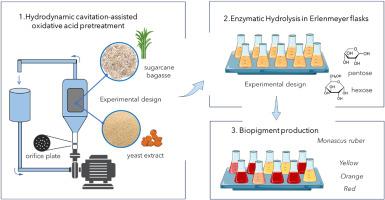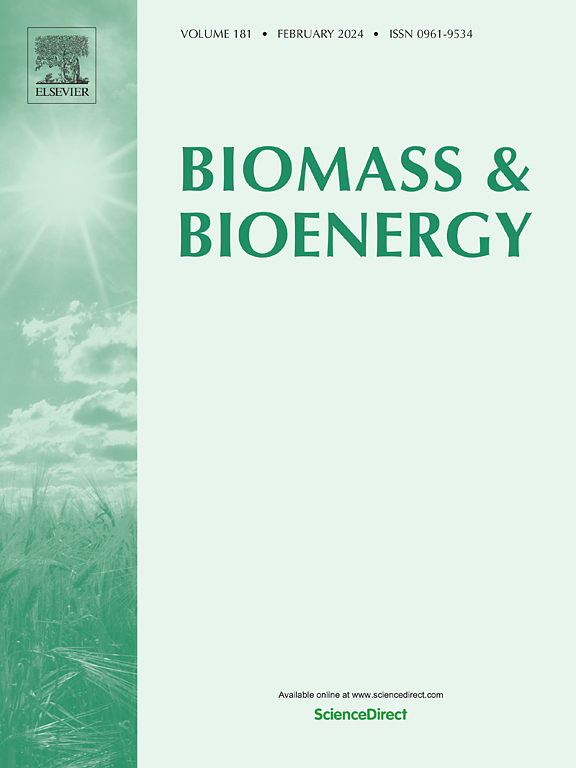在酵母细胞团存在下对甘蔗渣进行水动力空化辅助预处理以生产糖类,并将其用于莫纳斯卡-鲁伯(Monascus ruber)生物色素的生产
IF 5.8
2区 生物学
Q1 AGRICULTURAL ENGINEERING
引用次数: 0
摘要
在加入酵母提取物的情况下,对甘蔗渣进行了水动力空化辅助预处理试验。该预处理采用 22 中心复合设计实验进行研究。共进行了 11 次实验。然后,对预处理后的生物质进行了酶水解产糖测试。在酶水解过程中,研究了不同的酶负荷(15-20 FPU/克生物质)和酵母提取物浓度(0.25-1 克/升)。对酵母提取物的插入进行了优化,以同时促进纤维素分解酶注入预处理甘蔗渣的孔隙,同时抑制残留木质素造成的酶吸收。优化结果显示,在优化条件(20 FPU/g,1 g/L 酵母提取物)下进行酶水解后,葡聚糖水解率为 81%,木聚糖水解率为 78%。对富含来自碳水化合物聚合物的糖和来自水解酵母膏的氮源的水解物进行了评估,以确定是否可用于莫纳拉斯克氏菌(Monascus ruber)生产生物色素。用于酵母菌发酵的水解物显示,发酵 9 天后可产生黄色 15 AU(吸光度单位)、橙色 15 AU 和红色 20 AU 的色素。这些结果证明,使用酵母膏作为木质素的潜在阻断剂,可以提高糖的产量,同时也是 M. ruber 利用甘蔗渣水解物生产生物色素的氮源。本文章由计算机程序翻译,如有差异,请以英文原文为准。

Hydrodynamic cavitation assisted pretreatment of sugarcane bagasse in the presence of yeast cell mass for the production of sugars and their use for biopigments production by Monascus ruber
Hydrodynamic cavitation-assisted pretreatment of sugarcane bagasse tested in the, with the addition of yeast extract. This pretreatment was investigated using a 22 central composite design experiment. A total of 11 experiments were performed. The pretreated biomass was then tested for enzymatic hydrolysis for the sugars production. Various enzymatic loadings (15–20 FPU/g biomass) and concentrations of yeast extract (0.25–1 g/L) were studied during the enzymatic hydrolysis. Optimization of yeast extract insertion was performed to simultaneously facilitate the infusion of cellulolytic enzymes into the pores of the pre-treated bagasse concomitantly inhibiting enzyme absorption caused by residual lignin. The optimized results revealed an 81 % glucan hydrolysis yield and a 78 % xylan hydrolysis yield after the enzymatic hydrolysis under optimized conditions (20 FPU/g and 1 g/L of yeast extract). The hydrolysate rich in sugars derived from carbohydrate polymers and nitrogen sources derived from hydrolysis of yeast cream was assessed for biopigments production by Monascus ruber. The hydrolysate used for M. ruber fermentation showed the production of pigments with 15 AU (absorbance units) for yellow, 15 AU for orange and 20 AU for red after 9 days of fermentation. These results proved the efficiency of using yeast cream as a potential blocking agent of lignin in turn increasing the sugars production and a nitrogen source for the M. ruber for biopigments production from sugarcane bagasse hydrolysate.
求助全文
通过发布文献求助,成功后即可免费获取论文全文。
去求助
来源期刊

Biomass & Bioenergy
工程技术-能源与燃料
CiteScore
11.50
自引率
3.30%
发文量
258
审稿时长
60 days
期刊介绍:
Biomass & Bioenergy is an international journal publishing original research papers and short communications, review articles and case studies on biological resources, chemical and biological processes, and biomass products for new renewable sources of energy and materials.
The scope of the journal extends to the environmental, management and economic aspects of biomass and bioenergy.
Key areas covered by the journal:
• Biomass: sources, energy crop production processes, genetic improvements, composition. Please note that research on these biomass subjects must be linked directly to bioenergy generation.
• Biological Residues: residues/rests from agricultural production, forestry and plantations (palm, sugar etc), processing industries, and municipal sources (MSW). Papers on the use of biomass residues through innovative processes/technological novelty and/or consideration of feedstock/system sustainability (or unsustainability) are welcomed. However waste treatment processes and pollution control or mitigation which are only tangentially related to bioenergy are not in the scope of the journal, as they are more suited to publications in the environmental arena. Papers that describe conventional waste streams (ie well described in existing literature) that do not empirically address ''new'' added value from the process are not suitable for submission to the journal.
• Bioenergy Processes: fermentations, thermochemical conversions, liquid and gaseous fuels, and petrochemical substitutes
• Bioenergy Utilization: direct combustion, gasification, electricity production, chemical processes, and by-product remediation
• Biomass and the Environment: carbon cycle, the net energy efficiency of bioenergy systems, assessment of sustainability, and biodiversity issues.
 求助内容:
求助内容: 应助结果提醒方式:
应助结果提醒方式:


